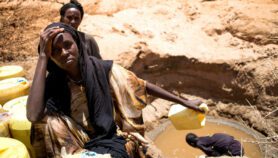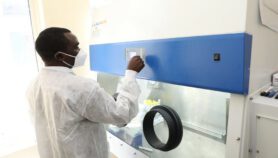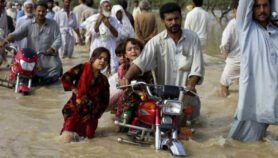Send to a friend
The details you provide on this page will not be used to send unsolicited email, and will not be sold to a 3rd party. See privacy policy.
A prominent voice has been missing from much of the growing international dialogue on ways of integrating science and technology more closely into development aid policies. It belongs to the US Agency for International Development (USAID), which is responsible for distributing the US aid budget to developing and other countries around the world.
There are several reasons for this absence. One is the fact that, to a much higher degree than almost all other countries, the United States tends to see goals such as the alleviation of global poverty as being the responsibility of charitable organisations and private foundations as much as that of the federal government, and technology transfer as the responsibility of the private sector, preferring to use its own aid money to reward countries for pursuing political goals that it approves.
A second is that much of US aid policy, again more than that of most other industrialised countries, focuses on projects that have a clear and identifiable pay-off for the United States itself; supporting capacity building in science and technology does not fit easily into this category, and has in the recent past been relegated to the bottom of the priority list when funding gets tight. (Ironically, in an earlier era, the promotion of scientific and technical collaboration was one of USAID’s strengths, as demonstrated, for example, but its role in creating the Green Revolution) .
Despite such factors, there are glimmers of hope that change may be in the air. The most obvious of these has been the decision by the USAID itself to commission a report from the National Research Council — the executive branch of the country’s three principal science, medicine and engineering academies — about the way that it handles science, and what could be done to improve things. The interim version of this report, which is now being discussed within the agency, recommends that it adopts a much clearer strategic approach to the integration of science and technology across its activities, including, for example, the appointment of a scientific advisor to its top decision-makers (see US aid agency ‘should pay more attention to science‘).
These conclusions should not come as a major surprise. They correspond closely, for example, to the arguments being heard elsewhere that, for example, rich nations will not be able to help poor countries achieve the UN Millennium Development Goals without paying adequate attention to building capacity in science and technology. They also reflect the main thrust of changes that are already being introduced in other institutions, such as the World Bank and the UK Department for International Development, both of which have recently decided to give science a greater role in their efforts to support developing countries.
Need for an ‘innovation framework’
Any move by USAID in such a direction is therefore to be welcomed. And a greater focus for discussion about the role of science and technology within aid efforts would have many advantages, for example in ensuring an effective follow-up to any decision in this area made at the G8 summit of the world’s main industrial countries later this year. Two areas of concern, however, need to be flagged up.
The first is the need to ensure, as has been argued frequently recently in this column, that the framework within which greater support for science and technology is offered is one that is firmly based within ideas about the need to support ‘systems of innovation’. In other words, it must not stem from a premise that greater investment in science and technology is itself sufficient to promote social and economic growth. Rather, that such investment is part of a broader package of support for every component of a successful innovation system, ranging from education at all levels from primary to postgraduate, to introducing intellectual property regimes that genuinely meet local needs (see Rethinking science aid).
Unsurprisingly, given the extent to which the United States itself is, in many ways, a prime example of the success of such an innovation-based strategy, this point is emphasised in the interim report of the NRC committee. For example, the report emphasises the need for USAID to incorporate ”technologies, research findings and modern management methods" in its projects. It also identifies "clusters of well-trained managers and [science and technology] specialists" — not scientific researchers on their own — as the important starting points for building up the capabilities needed within developing countries.
Nevertheless there remains a danger that, unless ‘science advice’ is adequately tempered with perspectives coming from outside the scientific community — for example, from those with experience in local innovation systems — it could remain marginalised with the agency. Those with long memories will remember the ill-fated history of attempts two decades ago to establish a semi-autonomous Institute for Science and Technology Cooperation. Launched by President Jimmy Carter in a speech in Caracas, Venezuela, in March 1978, this project was subsequently shot down by the US Senate. One reason was that some USAID officials were concerned at the time that too many key science-related decisions would be removed from their hands, and taken by those with less experience of implementing aid projects.
If USAID does, therefore, agree to implement a new science and technology strategy, it is essential that this is shaped around the concept of ‘innovation’, rather than the more traditional idea of science and technology as ‘drivers’ of change. Furthermore, this concept needs to be given both an economic and a social dimension. There is no shortage of proposals about how this might be done; two weeks ago, for example, a prominent Egyptian-born chemist suggested that it could take the form of providing matching funds to contributions from oil-rich Arab states towards building science and technology capacity within poorer countries in the region (see US urged to boost support for science in Arab states). The challenge will be to provide realistic goals, and set practical paths for achieving them.
Threats of ideological distortion
The second area of concern is a more complex one, since it is much more political. This lies in the need to find some way of divorcing aid funding from short-term US self-interest, and ensuring that aid genuinely meets the long-term interests of the developing countries to which it is offered. Unless this is done, USAID projects may not only fail to make a sustainable impact, but will also continue to generate resentment (reflected in the way that its work on biosafety regulation in Africa, regardless of its scientific merit, is widely seen as merely paving the way for US-based multinational corporations to sell their genetically-modified seeds).
It would be totally unrealistic, particularly under the current Republican administration, to expect the United States to adopt the policies already being pursued by other countries (such as the United Kingdom) of untying its aid funding — in other words, of ensuring that aid money is allocated to those who can use it most effectively to achieve a specific goal, rather than to promote the self-interest of the donor nation. However it is not unrealistic to ask for a greater scientific robustness in USAID’s own policies, particularly from those who would no doubt support the idea of evidence-based policy-making.
Recently, for example, the agency has come under criticism from Congress for the way in which it is alleged to have been pursuing a political agenda in manipulating the public presentation of data about the use of condoms. Thus two years ago, the USAID website carried two separate documents, both prepared by the Centers for Disease Control, describing condoms as being "highly effective" in preventing the spread of HIV infection. According to Democrat congressman Henry Waxman, however, one document was subsequently removed from the website, while the other was modified to state merely that condom use "can reduce the risk of HIV infection".
If funding for developing countries is to be effective, it is obviously essential that the scientific basis of the projects being supported is as sound as possible. And that can only be achieved through ensuring that USAID has the use of — and is allowed to respond to — scientific advice that is insulated from direct political pressures. Interference in such advice for essentially ideological reasons will eventually be self-defeating.
Future opportunities
Providing these two areas of concern — the need to place science and technology in a social and economic context, and to avoid the ideological distortion of science advice — can be successfully navigated, then the United States and its officials have much to gain by becoming more active participants in current discussions about enhancing science and technology in the developing world.
It would, for example, be naïve to suggest that promoting the widespread adoption of Western technologies would itself encourage peace in regions that have known generations of deep-seated political rivalries and conflict. Nevertheless, where such conflicts are generated by disputes over access to scarce resources (such as land), any use of modern science and technology to allow more to benefit from such resources will help reduce tension.
Other examples could easily be given to demonstrate how the long-term interests of the United States — including its security interests — can only be improved if the scientific and technological capacity of the developing world is enhanced, even if in the short-term this might appear to create a challenge.
The NRC report, even in its interim version, has set out a strong case for change in US policy in this area, suggesting ways in which the change might be implemented. It will be up to the administration (and to Congress) to take up the challenge, and ensure that the changes are made in the best interests of the world as a whole.













